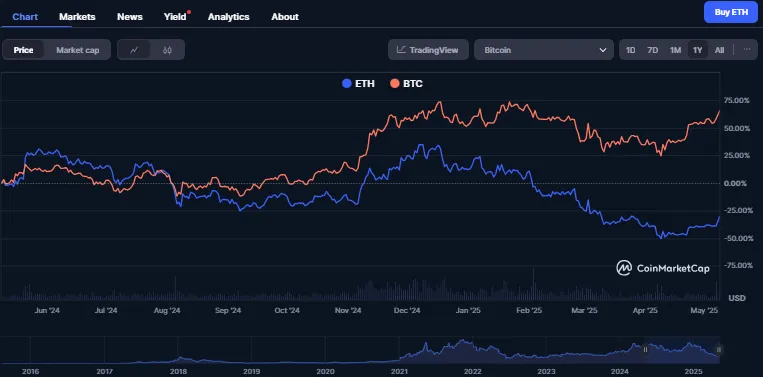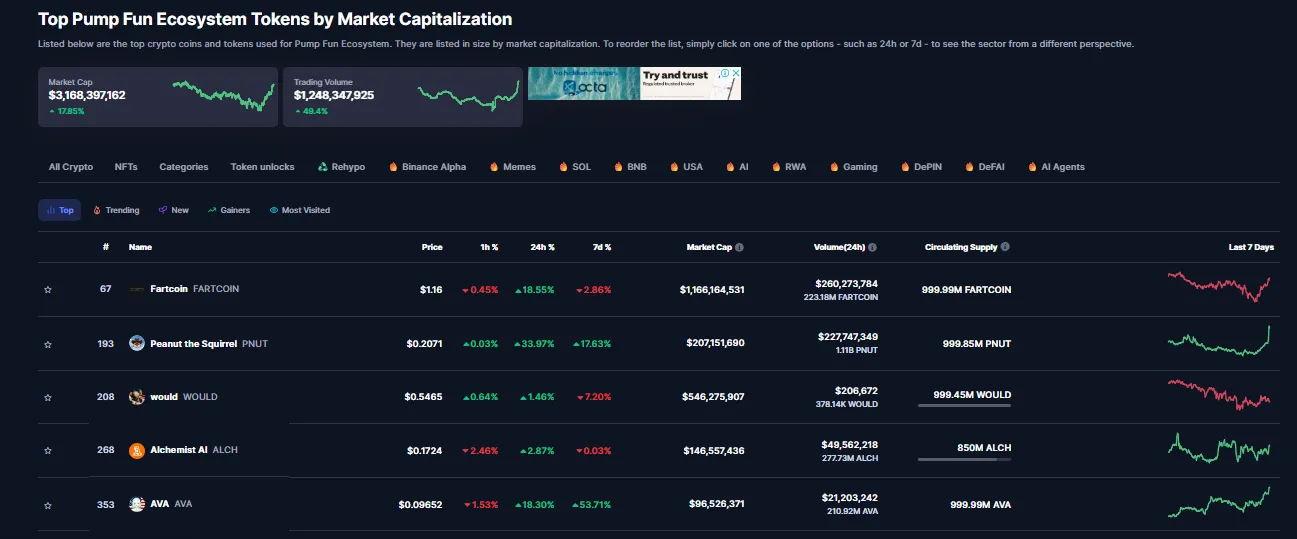Unless isolated from the world, almost no one in the cryptocurrency space has failed to notice Ethereum's decline over the past few months. Price trends, market dominance, and community sentiment - pick any metric, and they are all at historic lows! This top cryptocurrency seems to be experiencing a significant downturn - without even reaching a new all-time high in this cycle. However, in the past few days, Ethereum appears to be rebounding. Why has it been performing poorly for consecutive months? Can the current momentum drive its recovery?
Ethereum's Predicament
Ethereum is undoubtedly struggling. Since December 2024, whenever market sentiment shifts and causes an overall crypto market decline, only Bitcoin has been able to rebound to previous levels and break through, while Ethereum has fallen and barely returned to its original point.
Here is Ethereum's market performance in recent months. In November 2024, the market was in an upward phase, with Bitcoin priced around $96,405 and Ethereum at $3,703. On December 1, 2024, the market experienced a slight downturn, with Bitcoin dropping to $93,557 and Ethereum to $3,337. Although both top cryptocurrencies reached important price levels later that month, they failed to maintain their upward momentum and declined again.
About a month later, on January 1, 2025, Bitcoin was priced at $94,500, slightly higher than the previous month, while Ethereum further dropped to $3,298. By February 1, price data showed Bitcoin significantly falling to $84,381 and Ethereum to $2,236. Bitcoin reached $102,000 later that month, but Ethereum failed to rebound to its previous high. In fact, while Bitcoin recovered from $84,381 in February to $94,304 in April, Ethereum continued to decline, unable to retest its previous peak. Indeed, the BTC/ETH ratio has expanded, as shown in the chart data.

Source: CoinMarketCap
At the time of writing, Ethereum is trading at around $2,400, which is a decent increase considering its performance in recent months. However, it has yet to break into higher price ranges. What exactly is wrong with the Ethereum market? Let's analyze a few key points.
Bitcoin and Meme Coins Stealing the Spotlight
In recent months, Bitcoin and Meme Coins have stolen the spotlight. You may have heard about the U.S. government's plan to establish a Bitcoin reserve. This plan has been widely discussed among retail and institutional investors, with many U.S. states also working to establish strategic Bitcoin reserves. Texas and New Hampshire have made progress in this area, as have other U.S. states and some other countries.
The interest from sovereign nations has further attracted the attention of market whales and institutional investors. Recently, Michael Saylor announced that Strategy (formerly MicroStrategy) has added more Bitcoin to solidify its position as the listed company holding the most Bitcoin. Out of the total 21 million Bitcoin supply, Strategy holds over 555,000 Bitcoin.
While Bitcoin has been center stage and overshadowing Ethereum, meme coins have been doing the same. Unfortunately, these meme coins were not launched on the Ethereum chain. Fartcoin, one of the most successful meme coins in 2025 with a market cap over $1 billion, was launched on the Solana chain. The popular meme coin issuance platform PumpFun is also on Solana. You might not have noticed, but most of the hottest memeTokens created in late 2024 and 2025 came from PumpFun.

Source: CoinMarketCap
Thus, Ethereum clearly missed this wave. Moreover, discussions about decentralized finance (DeFi) have significantly decreased due to a lack of major innovations. Overall, Ethereum has not been at the center of any significant trend - nothing has been driving its price upward.
Liquidity Flowing to Subnets
Ethereum's high gas fees have always been a major obstacle to its growth. Worse yet, the Ethereum network is flooded with Layer-2 networks like Polygon, Optimism, Base, Linea, and Arbitrum. These Layer-2 networks compete with Ethereum for liquidity. With USDC's presence, these networks can complete operations without needing too much ETH. Not to mention the various activities possible on these Layer-2 platforms, which have reduced transactions through the Ethereum main chain. Therefore, while on-chain usage should have increased ETH demand, this is not the case now.
Competing Networks
We've already slightly mentioned how competitors like Solana are undermining Ethereum's market dominance. The fact is, Solana offers a better experience for developers and users. Who doesn't want a faster, cheaper, and more powerful chain? According to CoinGecko's report on Solana, the ongoing activity on the Solana chain reveals why it continues to attract more developers and retail investors. Here are some standout reasons:
Higher performance and scalability: Solana can process up to 3,000 transactions per second, theoretically even reaching 65,000 TPS. In any case, Ethereum's capacity of 15 transactions per second is completely incomparable. Considering Solana's extremely low costs when handling large transactions, the reason developers prefer it is obvious. Active and helpful ecosystem: The Solana ecosystem provides rich resources and tools for developers, promoting its growth. The Solana ecosystem offers developer toolkits and funding opportunities, enabling new projects to emerge seamlessly. Similar to Solana, Avalanche is also growing in popularity and capability. The institutional adoption of these Layer-1 platforms will further weaken Ethereum's dominance. Hyperliquid and Tron have made progress in perpetual futures trading and stablecoin markets, respectively.
Limited Institutional Interest
While global companies, market leaders, and nations continue to accumulate Bitcoin, Ethereum's situation is entirely different. According to CoinGecko data, few listed companies hold Ethereum, with a total value of less than $500 million, compared to Bitcoin's figure of over $50 billion.
The crypto ETF market shows the massive gap in demand between Bitcoin and Ethereum, with the latter failing to record high fund inflows like the former. ETF inflow data indicates that Bitcoin, with its first-mover advantage and widely accepted store of value function, has attracted massive investments from large investors. Although Ethereum has recorded billions of dollars in inflows in spot ETFs, its numbers still lag far behind Bitcoin.
Ethereum's Hope: Will It Make a Comeback?
Ethereum needs an awakening to regain market dominance, attract widespread investment, and achieve a value surge. At the time of writing, Ethereum has just activated an upgrade. This is a positive development, but it cannot solve the challenges of asset and data bridging in the Ethereum Layer-2 ecosystem. Competitors like Solana still hold an advantage because users can seamlessly switch between multiple decentralized applications (DApps). Nevertheless, this upgrade seems to have had a positive impact on Ethereum's price, with a 20% increase in the past 24 hours, reaching $2,400. Will this top Token make a comeback this time? We must wait patiently to see what improvements the recent upgrade can bring to the Ethereum chain and whether it is enough to get ETH back on track.







